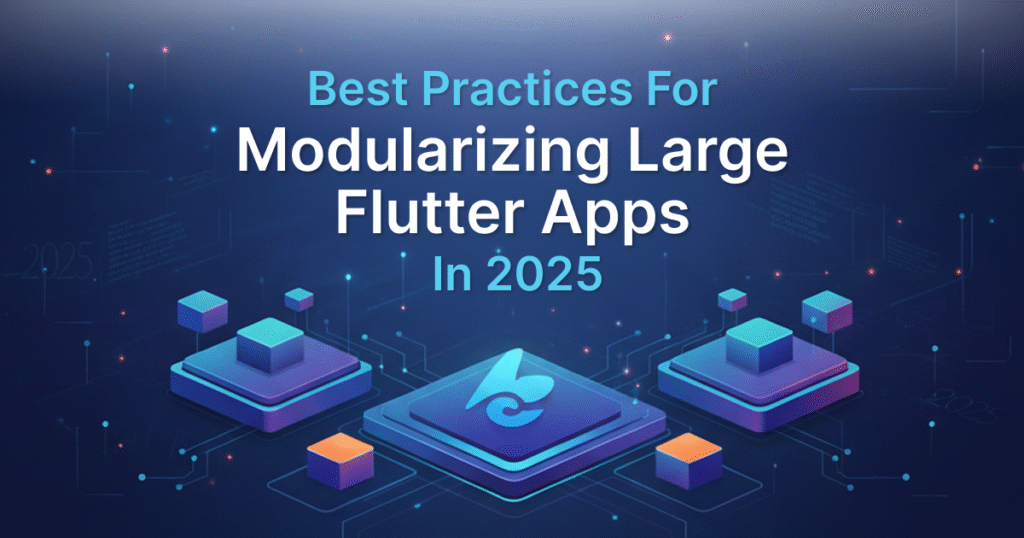As Flutter adoption continues to accelerate in 2025, mobile teams are building larger and more complex apps than ever before. With growth comes a major challenge: maintaining code quality and scalability. This is where modularization becomes essential. A modular architecture makes your Flutter project easier to scale, test, maintain, and onboard developers into. In this blog, we’ll explore the latest best practices for modularizing large Flutter applications in 2025, backed by real-world patterns used in production apps.

Why Modularize?
Before diving into the “how,” let’s briefly reiterate the compelling reasons to embrace modularization:
Improved Scalability: Teams can work on different modules concurrently with fewer merge conflicts.
Enhanced Maintainability: Smaller, self-contained modules are easier to understand and debug.
Easier Testing: Isolated modules can be tested independently, speeding up the testing process.
Faster Onboarding: New developers can quickly grasp a specific module without needing to understand the entire codebase.
Code Reusability: Modules can be reused across different parts of the application or even in other projects.
Key Principles of Modularization
Effective modularization relies on adherence to several core principles:
Single Responsibility Principle (SRP): Each module should have a single, well-defined responsibility.
High Cohesion: The elements within a module should be closely related and focused on achieving that module’s responsibility.
Low Coupling: Modules should have minimal dependencies on each other, reducing the impact of changes in one module on others.
Clear Interfaces: Modules should expose clear and stable APIs for interaction, hiding their internal implementation details.
Common Modularization Strategies
In 2025, several proven strategies are commonly employed for modularizing large Flutter applications:
1. Feature-Based Modularization
This is perhaps the most intuitive and widely adopted approach. Each major feature of your application (e.g., authentication, user profile, product catalog) becomes a separate module.
Advantages:
Clear separation of concerns.
Easy to understand and manage feature teams.
Facilitates parallel development.
Considerations:
Careful management of shared components and dependencies.
2. Layer-Based Modularization
This strategy organizes modules based on their functional layers within the application, such as:
Data Layer: Responsible for data fetching and persistence (e.g., API clients, local databases).
Domain Layer: Contains business logic and entities.
Presentation Layer: Handles UI and user interaction.
Advantages:
Enforces a clean architectural separation.
Promotes testability of individual layers.
Considerations:
Can become complex in very large applications if not carefully designed.
3. Core/Shared Module
A central module dedicated to housing widely used utilities, constants, themes, and shared UI components that are essential across multiple feature modules.
Advantages:
Prevents code duplication.
Ensures consistent styling and functionality.
Considerations:
Avoid making this module too large or having it depend on too many other modules, as it can become a bottleneck.
Practical Implementation Techniques
Using Melos for Monorepos
For large-scale Flutter projects with multiple modules, a monorepo setup managed by tools like Melos is highly recommended. Melos simplifies:
Dependency Management: Centralized control over package versions.
Script Execution: Running commands across multiple packages.
Publishing: Streamlined publishing of internal or external packages.
Package Structure and Naming Conventions
Maintain a consistent and descriptive package structure:
Root Folder: packages/
Module Naming: feature_auth, data_repository, shared_ui
Dependency Injection
Leverage dependency injection frameworks (e.g., GetIt, Riverpod) to manage dependencies between modules. This promotes loose coupling and testability.
Routing
Implement a robust routing solution that allows modules to navigate to screens in other modules without direct coupling. GoRouter is a popular choice for declarative navigation.
Best Practices Checklist for 2025
Practice | Description |
|---|---|
Adopt a Monorepo | Use tools like Melos for managing multiple packages effectively. |
Clear Module Boundaries | Define strict boundaries and responsibilities for each module. |
Utilize Dependency Injection | Decouple modules using a DI framework. |
Implement Robust Routing | Use a navigation solution like GoRouter for inter-module navigation. |
Shared Core Module | Centralize common utilities, themes, and UI components. |
Automate Testing | Ensure comprehensive unit, widget, and integration tests for each module. |
CI/CD Integration | Automate builds, tests, and deployments for individual modules. |
Documentation | Document module APIs and responsibilities clearly. |
Conclusion
Modularizing large Flutter applications is no longer optional in 2025; it’s a necessity for building scalable, maintainable, and high-quality software. By embracing the principles and techniques outlined above, teams can effectively manage complexity, accelerate development, and ensure the long-term success of their Flutter projects. Start small, iterate, and continuously refine your modular architecture as your application evolves.
Search
Categories

Author
-
Mariappan P is a Senior Front-End Developer with 4+ years of experience, specializing in Angular (3 years) and React (1+ year). He is passionate about building scalable, user-friendly web applications and leveraging modern technologies to deliver innovative solutions. Mariappan thrives on solving complex problems, optimizing performance, and creating seamless user experiences. Outside of work, he enjoys exploring emerging tech trends, contributing to side projects, and staying active through outdoor activities and fitness.
